Magazine front covers:
gatefold covers
This is one of several pages on Magforum.com about magazine front covers. Here, gatefold covers are examined with examples from Time-Out (2008),
Maxim's pull-out gatefold (2002), the Spanish magazine Quo with a combined gatefold and split cover (1998) and the New Yorker's four-part cover (2007).
What is a gatefold cover?
| A gatefold magazine front cover gives an extra fold-out page so a cover doubles in size to become a horizontal A3 sheet. The right edge of the gatefold is trimmed shy of the right edge of the issue. A gatefold can also be used on a back cover, so a magazine could have a double gatefold. Also, the cover could fold out several times.
Advertising usually drives the use of a gatefold. The result is that the advertiser can gain a 'triple' spread made up of the back of the double front cover and the first right-hand inside page. |
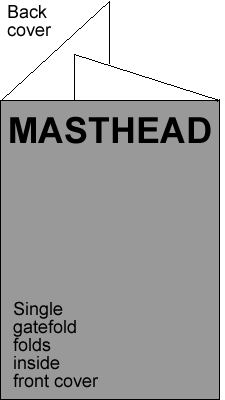 The gatefold tucks behind the main cover |
Time-Out: triple 'Heroes' gatefold
Time Out ran a triple gatefold to celebrate its 40th anniversary in 2008 (cover date September 25).A single image, though probably stitched together in Photoshop, was used across the four covers with 40 celebrities, fashionistas and media luvvies chosen as the 'men and women who make London' to celebrate its 40th birthday. Actress Helen Mirren was the only one given a chair
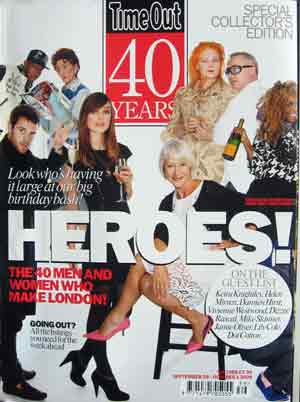
Time Out wheeled out 40 celebs, fashionistas and media luvvies to celebrate its 40th birthday, with Helen Mirren in pole position
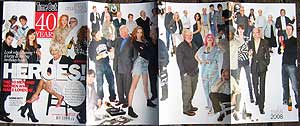
The four Time Out covers opened out
Maxim: pull-out gatefold cover
Maxim ran a variation on the gatefold with a pull-out pin-up cover in 2002 (dated March). The cover folds back on itself about three-quarters of the way from the spine – as seen in the vertical line of the cover on the right. However, there is then a reverse fold after about half a cover's width so the cover then comes back out to range with the right edge of the issue. The result is that the front cover pulls out to about twice its usual width with:
Men's magazine were great rivals at this time and gimmicks were common. FHM ran a drop-down cover. |
 Maxim: a pull-out gatefold allowed the men's monthly to run three pin-ups as a gimmick  |
Quo: gatefold with split cover |
|
| Hachette's Spanish monthly Quo used an ambitious combination of split cover and gatefold for this November 1998 issue. This is tricky to get right.
First, is getting the registration accurate in the printing, binding and trimming so both parts of the image line up. The two sides here overlap by 7mm. In addition, there's the problem of matching the colour because the two sides are different sheets of paper, which might have been printed at different times. In this case, it's pretty good, with images about 1mm out horizontally and the right side being slightly darker. |
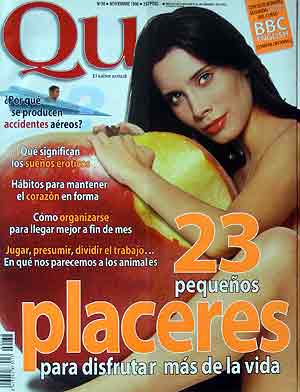 Quo: can you see the line of the split cover? |
New Yorker multi-part cover |
|
| The New Yorker cover dated 14 May 2007 was made up of four
covers, or part covers, each on top of the other. For this 'innovators' issue', Bruce McCalls was commissioned to do four illustrations. The edges of the four layered covers can be seen in this image of the layered New Yorker cover: one down the middle and the others on the right side. |
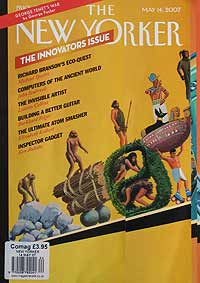 Note the line of the half cover running between the O and R of 'yorker' |
 Left: a half-cover that holds all the cover lines was designed to line up with the part cover lying underneath. However, getting an exact fit is difficult for the binder and the join can be seen in the above illustration of the whole cover |
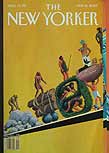 The next layer down is almost the width of the whole cover and is the left third of the illustration, with the title but without cover lines. |
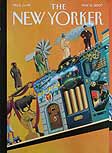 The third layer is a continuation of the image... |
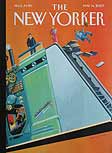 ... as is the final part. The covers could be laid alongside each other to give a triptych of the progress of mankind through innovation |


